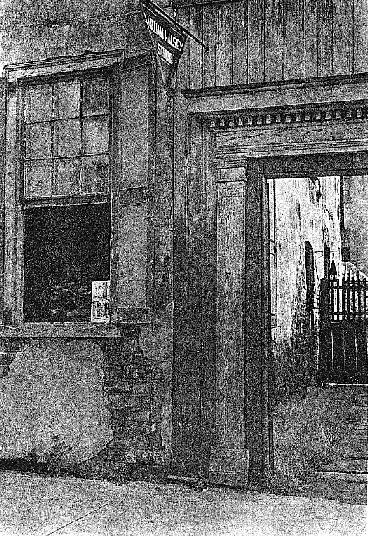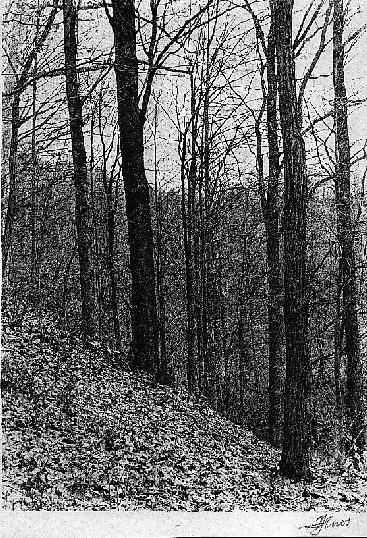The founder of the New Pictorialist Society, Ed Romney mentioned in one of his articles in the Bulletin, that a fellow named Franklin Enos was making prints using the Casein Bichromate process and urged any of us who were interested in trying the process to write to Franklin for information.
Franklin and I started a correspondence that continued for several months. He sent me complete instructions on the process including small jars of pigment and powered casein (Sodium Caseinate).
At the start of this "training session" Franklin composed a still life of all the ingredients and equipment required, photographed the arrangement, prepared a casein print of the negative and sent it to me.
I made prints following his instructions and sent them to him for critique and evaluation. Gradually I learned how to make passable prints relying greatly on the master's help and patience.
Franklin was continually experimenting with formulas and methods, continuing to learn the process. He always referred to his formula as his "current formula" implying constant refinement. He always encouraged me to use his methods only as a starting point and urged me not to attempt to duplicate his printing style but to use the process for my own creative endeavors.
Franklin Enos died September 30, 1983, in his eighty seventh year. As Len Oppenheimer wrote in his memoriam for him in the January/February 1984 AVISO, "Franklin, although he never would admit to mastery of a process, was in truth the master of many control processes but his great love was the Casein Process which be had refined to as much of a science as a photographic process can be".
In the fall of 1984 Stan Cummings gave me a formula for making Ammonium Caseinate from powered milk. I had not been working in the Casein Bichromate process for a couple of years because I could not find a source for Sodium Caseinate (casein in power form). During this time I had been working Multiple Gum Bichromate using Stan Cumming's formulas and techniques. I learned that it was very easy to make casein from powered milk and I started my experiments combining Stan's techniques with my home-made Ammonium Caseinate.
Powered Sodium Caseinate is difficult to dissolve in water based solutions. I had success making my own colloid, which I guess would be called Ammonium Caseinate, although I am not a chemist so I'm not sure if that is right.
The Casein Bichromate Process is very similar to the Gum Bichromate Process. In fact as far as a process is considered, it is almost identical. While the process is the same, the look of a Casein Bichromate print and a Gum Bichromate print is quite different.
a)Gum Bichromate prints have a transparent watercolor appearance where Casein Bichromate prints resemble gouache.
b) Casein Bichromate prints have a longer scale than Gum Bichromate prints. A fairly long series of values can be achieved with one impression where Gum Bichromate prints require several runs or "multiple impressions." Franklin Enos could make a Casein Bichromate print containing a range of tones approaching a carbro print with one run. (I have never been able to accomplish this. I need at least two impressions to get highlight, midtone and shadow tones.)
c) Casein is more forgiving than Gum. The wet image is tougher, allowing more vigorous manual intervention with strong water spray and direct brush work. Gum Bichromate prints require much more care and delicacy in soaking and clearing. Casein Bichromate prints withstand the rigors of multiple printing better than Gum Bichromate prints.
d) Ammonium Caseinate is much easier and quicker to make than liquid Gum Arabic. The best Gum Arabic is made from "chunks" of Acacia tree sap. It must be dissolved slowly in water, over several days and then filtered to remove traces of Acacia tree bark, elephant hide and rhino horn.
The Casein Bichromate process is not "better" than the Gum Bichromate process. It is just different enough to make it interesting and worthwhile to learn.
I will describe my method and you can jump off from there;
Briefly it goes like this,
a) I make a colloid mix, in this case it is Ammonium Caseinate.
b) I made a "basic mix" which is the colloid mixed with pigment.
c) I made a coating mix which is the basic mix combined with water and the sensitizer.
d) I coat the paper, expose and develop the print.
1. The Colloid. Mix 1/4 cup non fat powered milk with 8 oz. hot water. Mix 3 cc Glacial Acetic Acid with 7 cc water. Add to the milk mixture. A curd will form immediately. Separate the curd from the whey using a fine strainer or a piece of fine mesh and gently wash the curd under cool water until the acid smell goes away. This should take five minuets. Put the washed curd in a beaker and add 75 cc of household Ammonia. Buy a fresh bottle, it loses its strength quickly once the bottle has been opened. It takes about 24 hours for the curd to dissolve in the Ammonia. Put it in a small jar after it is completely dissolved. I never add any preservative. I use it before it goes off.
2. The Basic Mix. For pigments I use Winsor Newton transparent watercolors. I have a gunpowder scale so I measure in grains. Each color requires a different amount of pigment. Not all colors work well. As an example Chrome Oxide gives unpredictable results. It stains and does not react well with Ammonium Bichromate. I had best results with Lampblack. I do not know how you measure so you will have to experiment. As is true in the gum process, too much pigment causes staining.
Mix 40 grains or 2.6 grams WN Lampblack to 50 cc of the Casein. Put this in a small jar.
For other WN colors try these proportions:
| Color | For 50 cc of colloid |
| Alizarin Crimson | 52 grains or 3.5 grams |
| Thalo Blue | 40 grains or 2.6 grams |
| Cadmium Yellow | 60 grains or 4 grams |
| Hansa Yellow | 12 grains or .8 grams |
| Burnt Sienna | 60 grains or 4 grams |
| Burnt Umber | 60 grains or 4 grams |
3. Sensitizer. Either Potassium Bichromate or Ammonium Bichromate (AB) will work. I used Ammonium because I had it. Mix a saturated solution of AB. You don't need much so don't mix much. Ammonium Bichromate is faster than Potassium.
4. Coating mix. I always mix the same quantity of coating mix; 15 cc. I then vary the proportions of the ingredients for best results. This is a standard mix for lampblack. This makes 15 cc of coating mix. Mix 4 cc of basic pigment mixture with 7 cc of distilled water (always use distilled water for all of these processes) with 4 cc of saturated AB to make 15 cc in all.
I can coat five 8 x 10 pieces of paper with 15 cc of this mix. This is a thin coat. I usually make from two to five runs on a print. More than that and I get staining no matter how thin I make the mix. You will vary the proportions for your own best results.
5. Exposure. This is a function of your light source. Start with an exposure you use for gum and go from there.
6. Development. Soak the exposed print is a tray of room temp water for ten to fifteen minutes. This softens and swells the colloid and clears most of the Bichromate out. Place the print in a sink in a tray of water and spray with a hose with a spray attachment on the print, through the water covering the print. This allows you to start with a gentle development spray. Depending upon the progress of the development you may increase the spray force to the point of spraying directly on the print surface.
For stubborn prints, try this; following the initial soaking, transfer the print to a tray containing a weak sodium carbonate solution. I mix two teaspoons of sodium carbonate to a quart of water. Soak this for ten to fifteen minutes, then spray to develop. If this does not work, discard and start over with less exposure.
That's about all I can tell you. I assume you know a method of registration for making multiple runs. Give it a go and let me know how you make out.
Prints by Franklin Enos

Notes on back. "Charlston SC 1933 Original Baby Ikonta ( Half VP) enlarged from same size diapositive - both with Kodak Fine Grain Positive film in D-52." 4 3/4" x 6 3/4"

Notes on back. "Bird Sanctuary - Rochester NY. Leica M2 - Somm Summicion f:2" signed on front "F Enos." 4 7/8" x 6 7/8"